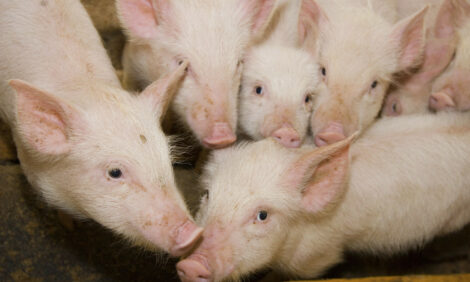



Swine Infection Screening Using Oral Fluids
GLOBAL - Large numbers of pigs could be screened more quickly and cost-effectively for a range of common pathogens, such as PRRSV, SIV and PCV2, thanks to a new PCR-based test system developed in the US.
The system uses samples of oral fluids which can be obtained quickly and easily by leaving a cotton rope in each pen for pigs to chew on. After 20 minutes or so, the rope can be retrieved and the saliva and gingival crevicular fluid squeezed into a sample bag and represents a pooled sample from the group.
Studies have demonstrated that oral fluid samples collected in this way can form the basis of a quick and cost-effective method for screening a range of common viral pathogens. The samples were tested using a commercially available sample preparation and real-time PCR test system which can isolate and identify viral nucleic acid in a matter of hours.
For PRRS, pooled samples of oral fluids were collected from groups of experimentally infected pigs using the rope technique, along with serum samples from each individual pig on the same days. Both serum samples and oral fluids were processed using the same Applied Biosystems preparation system and real-time PCR test, both of which were supplied by Life Technologies. The results showed that PRRSV nucleic acid was detectable in both serum and oral fluid samples from the day of infection through to 40 days after infection.
For PCV2, 24 pigs that were free of PRRSV and SIV were divided into four pens in separate rooms, and challenged with two different virus strains (PCV2a and PVC2b) at different times. One pen acted as a (non-challenged) control. Oral fluids were collected regularly up to 140 days after initial challenge and tested using real-time PCR. High titres of PCV2 were detected from day 12 to day 28 post infection and virus was detectable throughout the entire testing period (days two to 98).
For SIV, a total of 180 spiked oral fluid samples were tested using real-time PCR, and subtyping reagents were also used to identify haemagglutinin and neuraminidase subtypes. The results showed that SIV nucleic acid was detectable in oral fluid samples spiked with high, medium and low copy numbers of SIV, and all positive samples could be successfully sub-typed.
"Collecting samples in this way is far less invasive for the pigs and so avoids unnecessary stress. And because all of the pigs will chew on the rope, it provides a very broad sample from the group, which is the key to assessing overall herd health," said Christina Boss, European Professional Service Veterinarian for Life Technologies.
"In addition, if the pooled sample provides a positive result, then the animals in that pen can be tested individually to identify those that are infected."
"These results show that the simplicity of oral fluid sampling, combined with the speed and sensitivity of a PCR-based system, provides a practical and cost-effective way of monitoring large numbers of pigs for common virus pathogens."
The use of a semi-automated, PCR-based diagnostic system means that nucleic acid purification can be achieved in just 25 minutes and results from the real-time PCR available in 90 minutes. The molecular test is very specific and reliable, so the veterinarian can initiate individual testing as quickly as possible and make confident recommendations to the producer.
Screening for PRRS using samples of oral fluids has been gaining popularity over recent years because large numbers of pigs can be tested without increased cost or labour. The new research is due to be presented as a poster at the ESPHM meeting in Bruges in April.
Further Reading
|
| - | Find out more information on PRRSV by clicking here. |
For more information about swine diagnostics, click here or connect to the Thermo Fisher Scientific Swine Resource Center.








